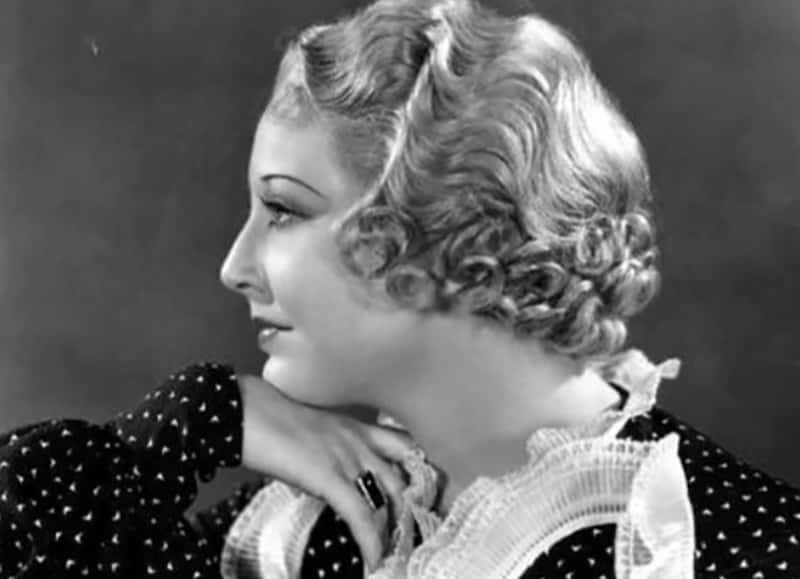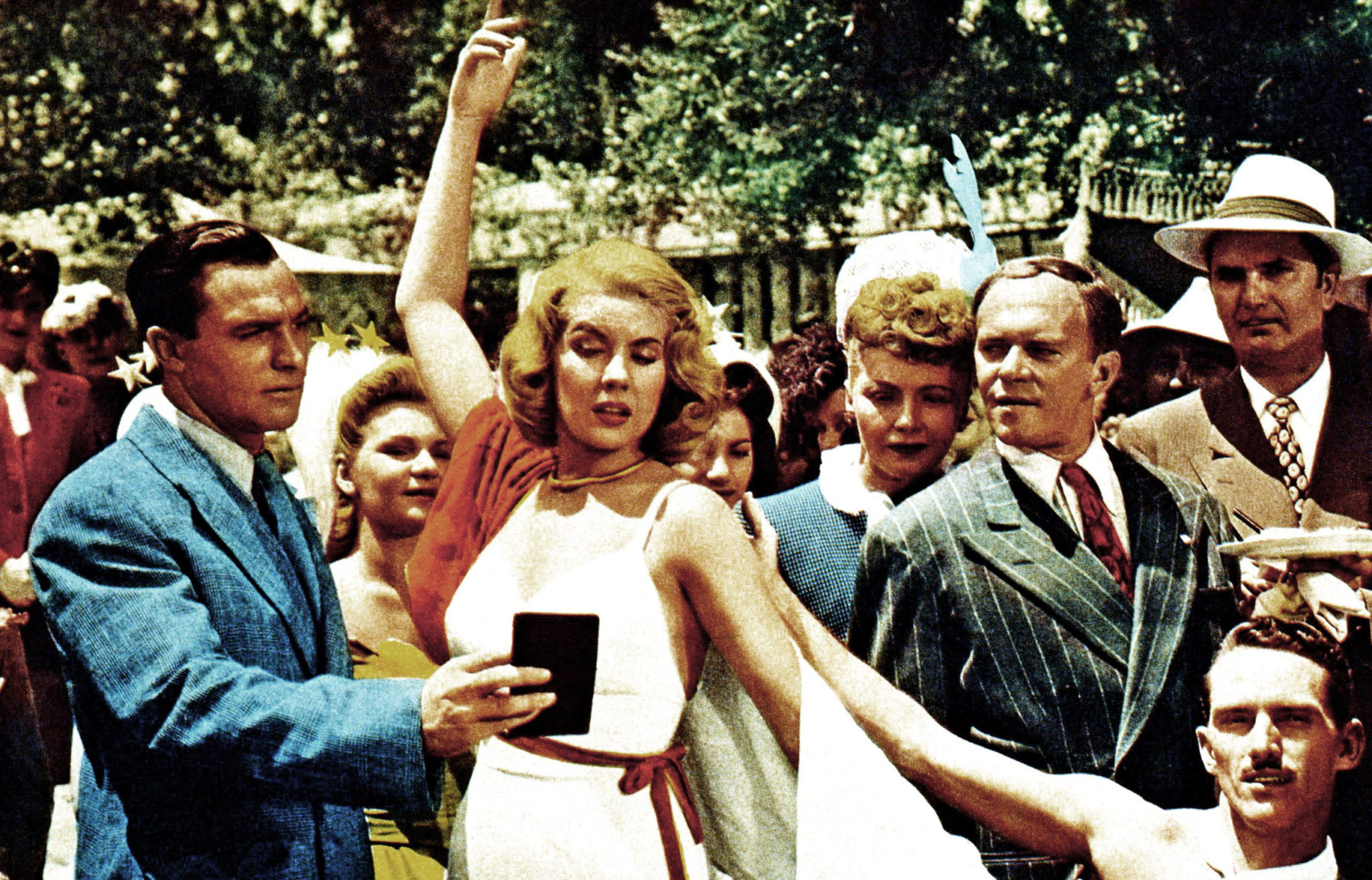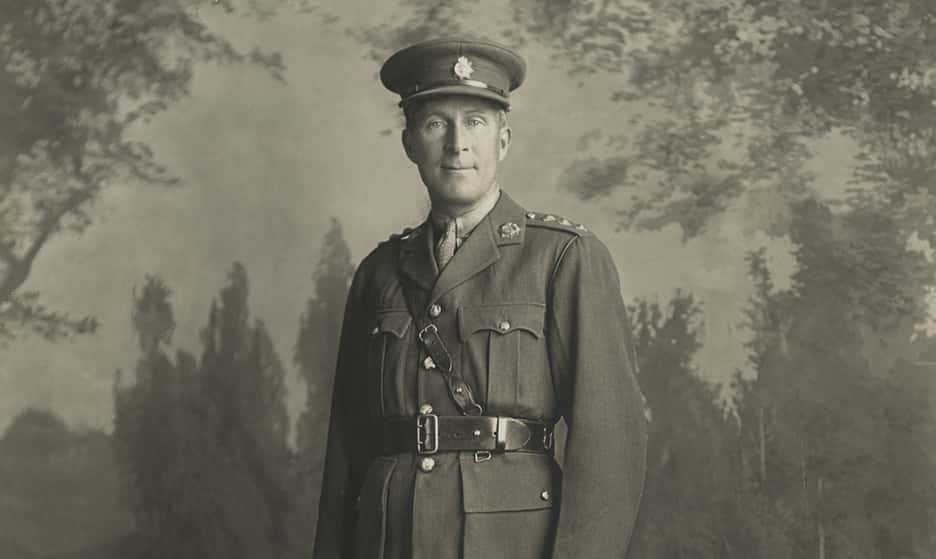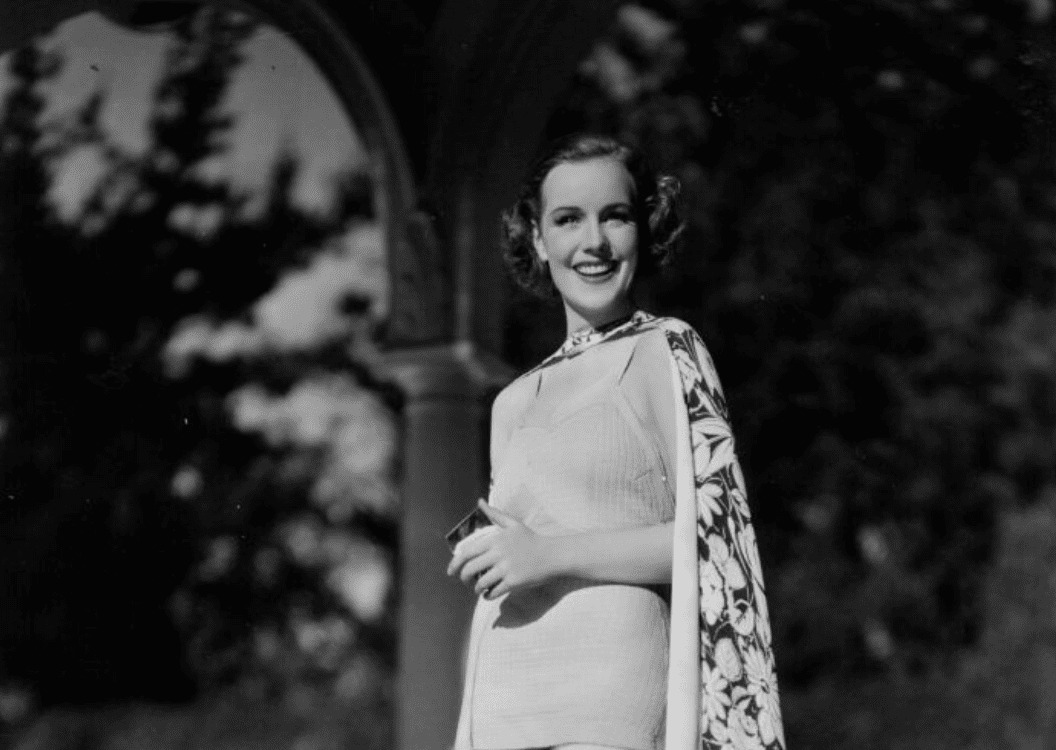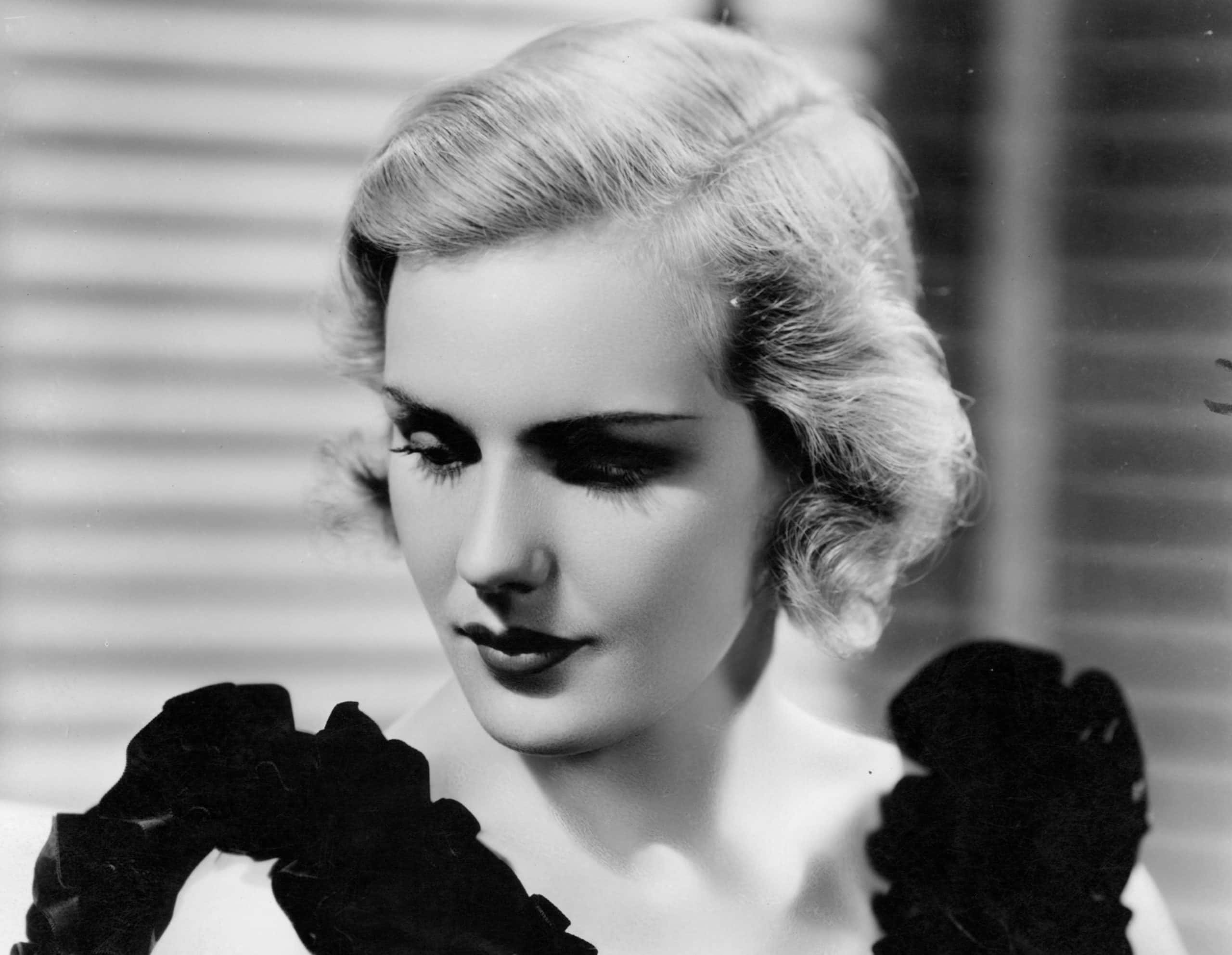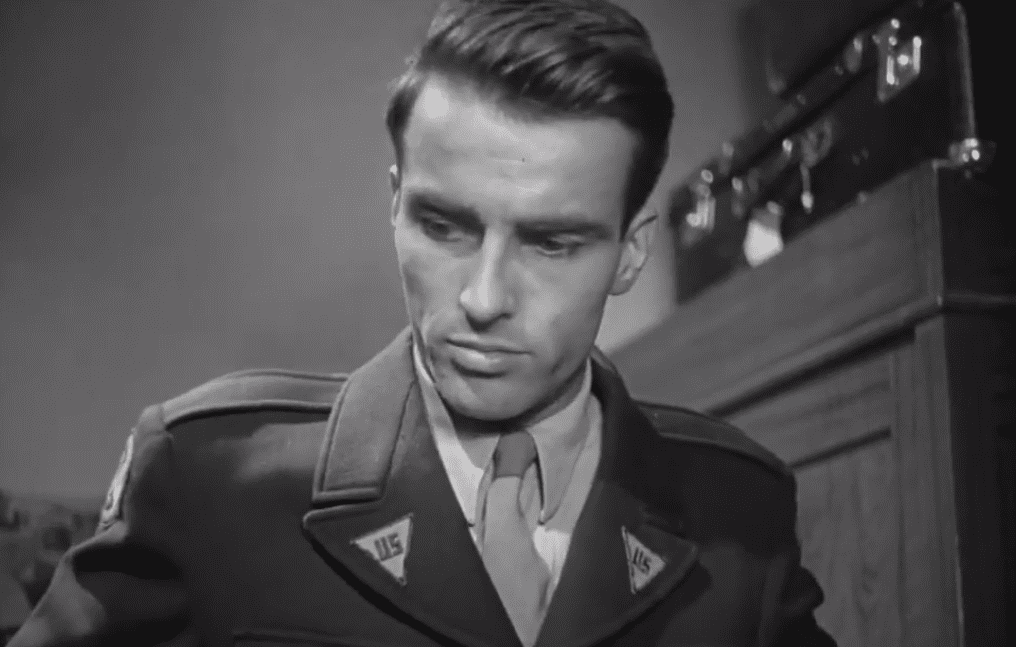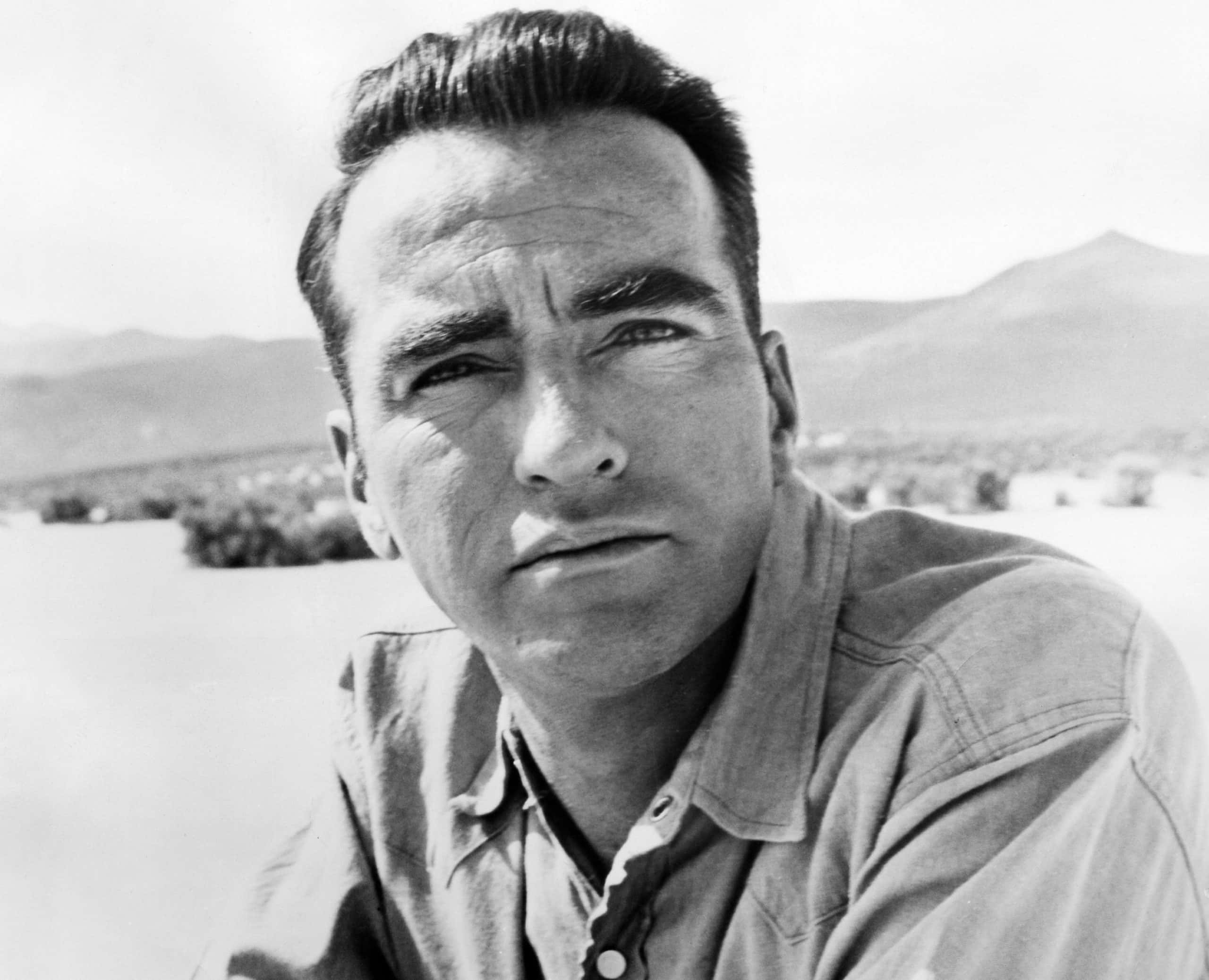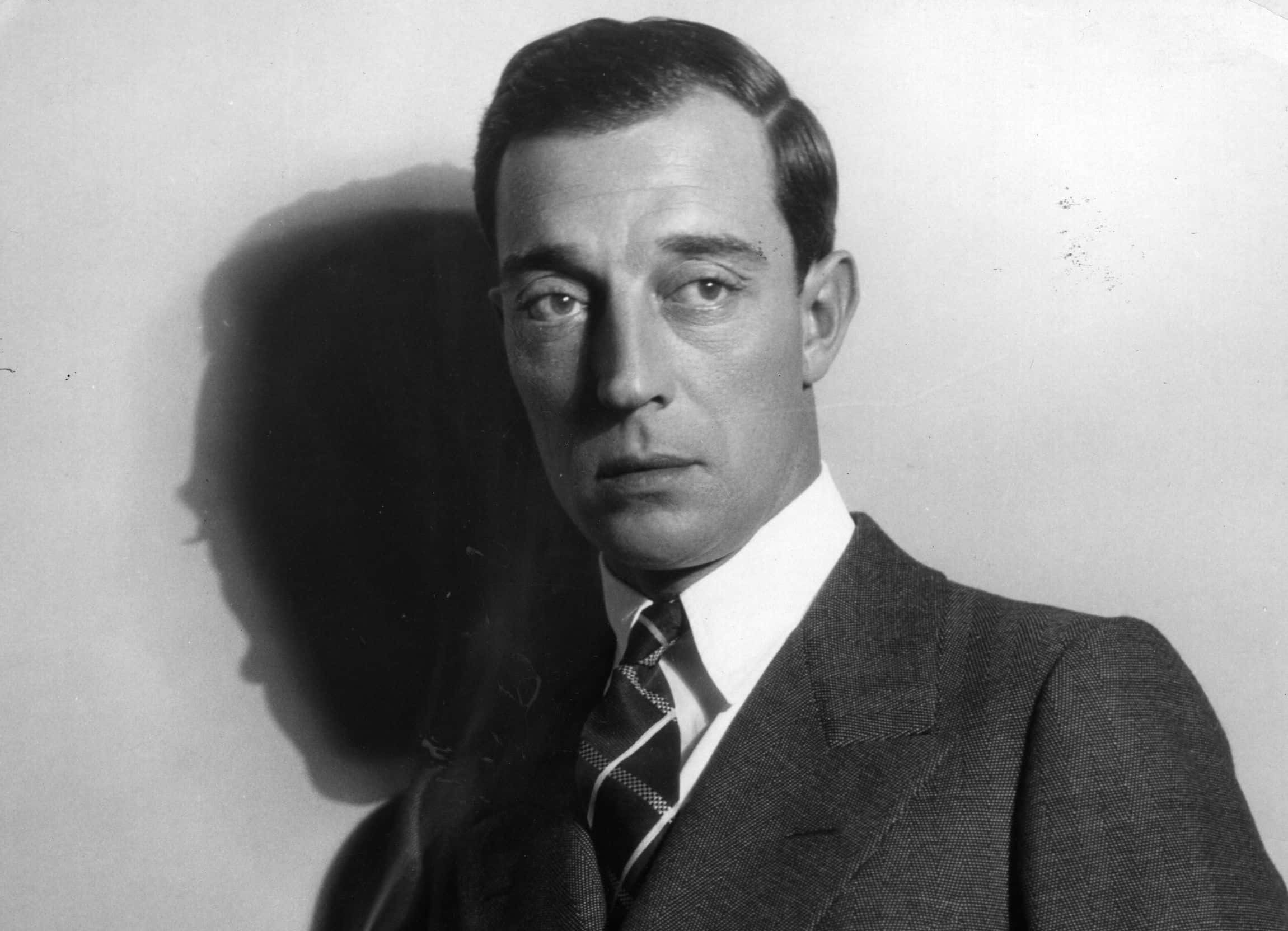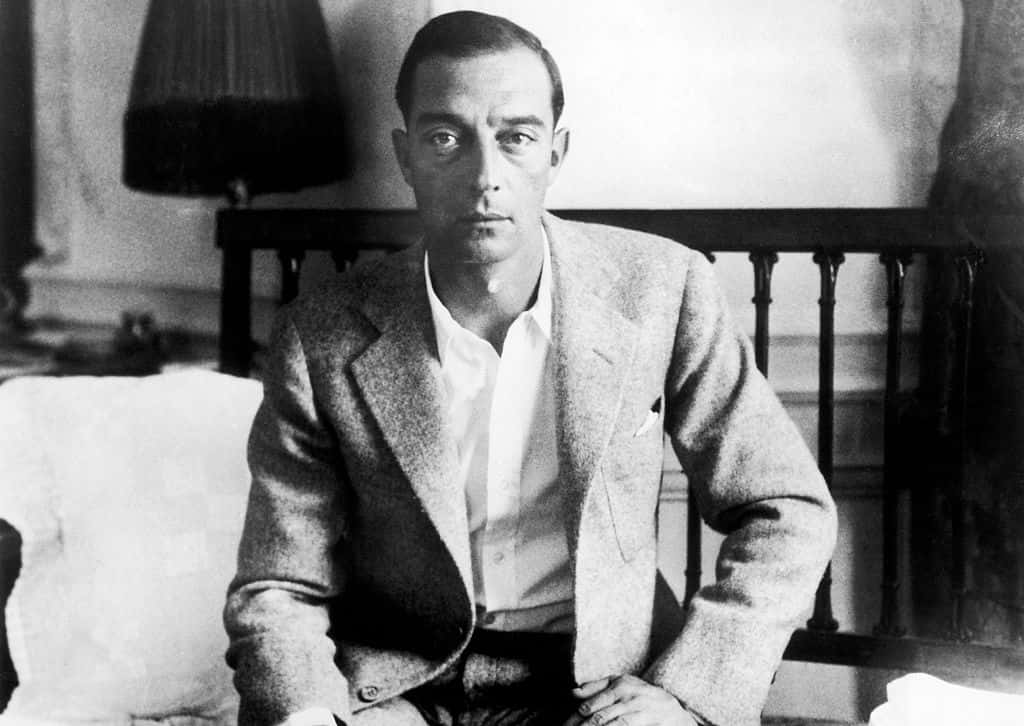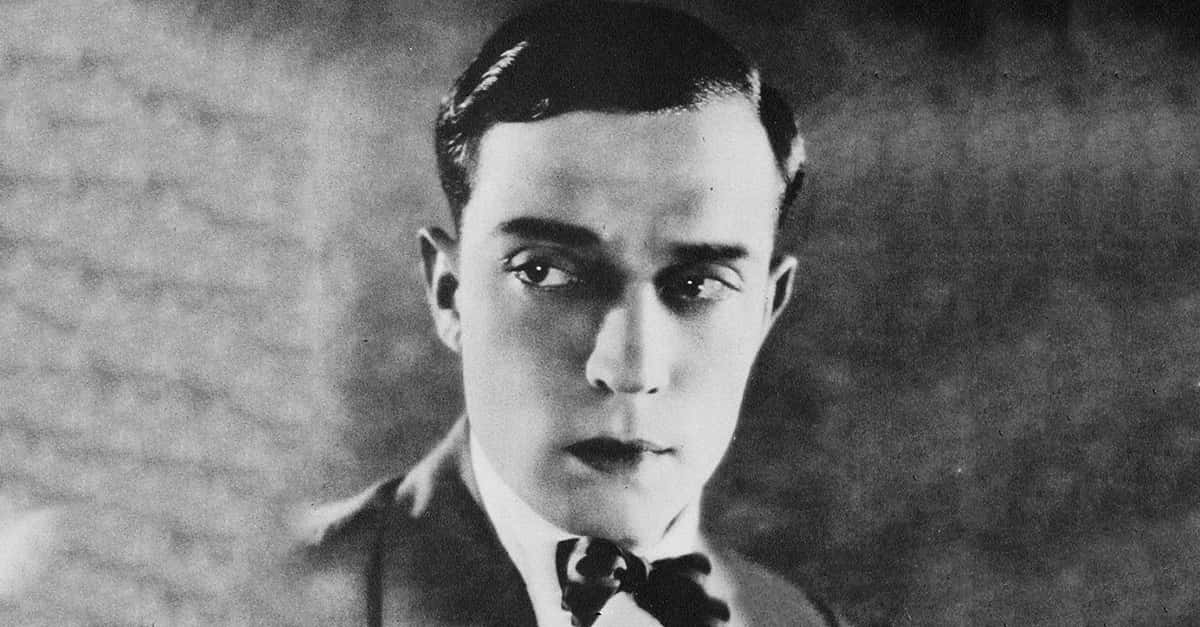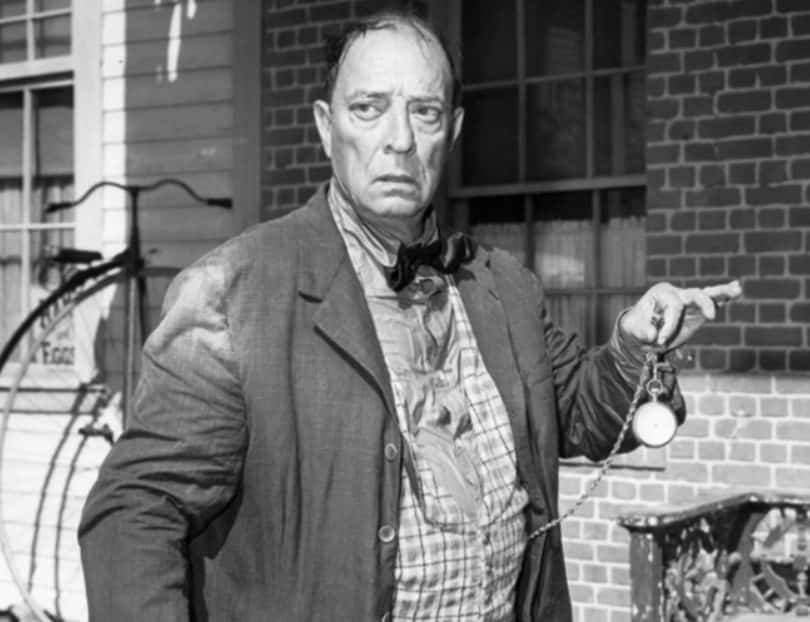Old Hollywood. The Golden Age. The words evoke glitz and glamor. Imagine Technicolor stars in satin dresses and debonair screen heroes eating lunch at the Brown Derby before heading back to the MGM lot to stand under the bright lights, giving iconic performances that’ll live forever on film. But behind the scenes, the truth was much darker. Passionate affairs, chilling secrets, and twisted transgressions were all as much a part of daily life as a director yelling cut. Forget Brangelina and One Night in Paris—they're positively mundane compared to the wildest Old Hollywood scandals, so read on.
Thelma Todd, The Ice Cream Blonde
When it comes to the iconic blondes of Hollywood's Golden Age, one name isn’t cited as often as Marilyn Monroe, Grace Kelly, or Jayne Mansfield—even though she certainly made her mark before her life was tragically cut short. Thelma Todd not only appeared in a prolific number of films during her time in Hollywood, she was also the life of the party and the center of her social circle. Todd lived an extraordinary if brief life before her passing (under extremely mysterious circumstances) at the age of 29 years old.

Surprising Beginnings
Thelma Todd never expected to end up in Hollywood. Born to working-class parents in Lawrence, Massachusetts in 1906, Todd wanted to become a teacher. She enrolled in the teaching program at Lowell Normal School, but her mother, recognizing that Todd had both beauty and charm, encouraged her daughter to enter beauty pageants. She won several, and even went on to become Miss Massachusetts in 1925.
Making It Big
In a tale that’s become stereotypical to the trajectory of classic Hollywood starlets, a talent scout "discovered" Todd while she was fulfilling the duties of her pageant title. Seduced by the glamor and possibility that Hollywood had to offer, Todd left Massachusetts and signed with Paramount—the beginning of a very rapid series of major life changes.
Welcome To La La Land
Todd couldn’t have picked a better time to get to Hollywood if she’d tried. She arrived at the tail end of the silent movie era, when many starlets struggled to transition to the "talkies"—something that wasn’t a problem for Todd, whose voice was an integral part of her acting talent. She initially made a name for herself in comedy shorts, appearing with other stars of the day. Eventually, the studios cast her against actress ZaSu Pitts in 1931, and they became a wildly popular female comedy duo.
Changing It Up
In that very same year, a busy one for Todd, she met a man who would change her life—both for better and for worse. Producers cast Todd in Roland West’s Corsair. While Todd had mostly appeared in comedies, West's genre was proto-noir dramas. In Corsair, he cast her as a femme fatale type. The film made her career take off—but that wasn’t the only dramatic shift that Corsair would cause for Todd.
Mixing Business With Pleasure
She later began a romantic relationship with West—but not before a short-lived marriage to Pat DiCiccio, an agent and film producer who also had ties to notorious mob figure Lucky Luciano. At the height of her career, Todd and DiCiccio tied the knot, but their relationship was a toxic one. The pair had a penchant for getting into drunken fights in public, and DiCiccio was clearly abusive. One brawl ended with a ruptured appendix for Todd and a broken nose for DiCiccio.
A Dangerous Game
The pair would divorce in 1934, two years after marrying, but for Todd, getting DiCiccio out of her life wasn't quite so simple. That year, she opened Thelma Todd’s Sidewalk Café along the Pacific Coast Highway, which became a familiar haunt for the Hollywood glitterati. The place was an instant success, and the elite crowd that filled its parking lot every night got the attention of local a mafioso.
 Getty Images
Getty Images
Not Playing By The Rules
Allegedly, they wanted to operate a gambling operation out of the Café, knowing that many of its regular clients were quite wealthy. Some people speculated that they pressured Todd to sell, but she refused. This choice may have come back to haunt her. After her divorce from DiCiccio in 1934, Todd became involved with director Roland West, whom she’d previously worked with on Corsair.
 Corsair (1931), United Artists
Corsair (1931), United Artists
Homewrecking
At the time, West and his wife Jewel Carmen were still together on paper, but estranged. Regardless of his status, West acted as a partner in the Sidewalk Café with Todd, and agreed with her when she decided to refuse the mobsters who wanted to transform it. But still, their relationship had its own problems, as would become apparent on one fateful morning.
A Tragic Loss
Days earlier, on the night of December 14, 1935, Thelma Todd had gone to the Trocadero, a local restaurant, to attend a party. Although her ex-husband DiCiccio was there, lurking in the background, Todd enjoyed the affair. But behind the scenes, trouble was brewing between Todd and her paramour, director Roland West. He'd demanded that she follow a curfew of 2 AM.
Too Little, Too Late
At the time, both Todd and West lived in neighboring apartments over the Sidewalk Café. Todd missed her "curfew" after her chauffeur drove her home. West had locked the door to the Café at 2 AM sharp. What happened next is the source of one of the greatest mysteries and wildest scandals of Old Hollywood. On the morning of December 16, 1935, Thelma Todd’s body was found inside a car in West’s ex-wife Jewel Carmen’s garage.
A Senseless Loss
West still owned Carmen’s home, which wasn’t very far from the Sidewalk Café where Todd's chauffeur had dropped her off early in the morning of the 15th. The coroner performed an autopsy. He found that carbon monoxide poisoning was responsible for the tragedy. Law enforcement said it was accidental. They speculated that Todd had gone into the garage to stay warm after West locked her out. A jury convened, as part of the coroner’s inquest recommended further investigation.
Whodunnit?
The grand jury probe that followed lasted four weeks. They eventually came to the conclusion that what happened had been "accidental with possible [self-harm] tendencies". This was despite the fact that everyone who knew Todd, including the chauffeur who’d driven her that night, said it would be completely out of character for the bright young actress.
Prime Suspects
Beyond that, the combination of her fame, her business, and her tumultuous relationships raised more suspicion that something even more sinister had occurred. Attention fell upon both Pat DiCiccio and Roland West following Todd’s passing. After all, DiCiccio had been at the Trocadero at the same time as Todd mere hours before it happened, and there were accounts that they’d fought there.
Not A Nice Guy
There were also his mob connections. Di Ciccio's associate, mafioso Lucky Luciano, was in Los Angeles that night. Many who knew Todd speculated about the two men's potential involvement. Then, of course, there were West’s callous actions toward Todd, including the curfew and lockout, which drew attention to him as a suspect. The pair's proximity with each other in both romance and business—the latter of which may have been struggling—was as much a red flag as anything else.
The Suspects Pile Up
There were other discrepancies at the scene that caused many people to raise questions. First, there was the fact that the engine was off and the fuel tank was full when law enforcement found Todd in the garage. Then, there were friends, including Jewel Carmen, who insisted that they’d seen Todd after the chauffeur dropped her off, but before her passing. Carmen even claimed that Todd had been with a mysterious new lover that day.
One For The Evidence Room
Some people claimed that Todd’s body had visible marks of harm on it, and that the notoriously corrupt Los Angeles authorities had covered them up. Accusations flew. People even suspected Todd’s mother. Just before her daughter’s passing, someone heard her say that she planned on building a large mansion. Many wondered how she could afford such a project.
A Mystery For the Ages
No one ever uncovered the real truth about Todd’s final hours on earth. Was she secretly distraught, leading to her taking her own life? Was it an innocent accident as the coroner said? Or, was it a much more disturbing possibility: Did she die in a state of sheer terror? Every few years, another magazine story, book, podcast, or film draws attention to her life and tragic end, leading to more speculation about the potential cause.
Back On The Books
Recently, the loss of Gloria Vanderbilt was the thing that brought up this sad tale up again, as Pat DiCiccio had gone on to marry Vanderbilt after Todd's passing. Their marriage was without a doubt as tempestuous as his union with Todd, and his horrible history revived interest in Todd’s heartbreaking story. Sadly, as the years pass, it’s less and less likely we’ll ever know what really happened to Thelma Todd. It's a wild mystery, but those twists and turns are nothing compared to the tale of Marie McDonald...
Marie McDonald, The Original Gone Girl
Ah, Marie McDonald. If anyone took Hollywood for a ride down Crazy Lane, it was this girl. Not only was she a legendary maneater—she had eight different husbands in 25 years!—she was also at the center of one of Hollywood’s strangest mysteries. Let’s set the stage: After some supporting roles as busty blondes, McDonald’s career never quite happened. By 1957, it was looking like that big break would never come. Things, uh, would not improve for a while.
A Desperate Ploy
In January of 1957, a group of men called McDonald’s mother and husband, claiming they’d abducted the B-list star. Her family was terrified—but then, things started to get weird. McDonald managed to sneak off and make covert calls to her husband, which is fair enough. However, in a classic case of starlet priorities, instead of calling the authorities or her mom, McDonald dialed her agent. Even worse, she also called a freaking gossip columnist.
 It
It
Strange Magic
By this point, her abductors panicked, blindfolded Marie McDonald, and promptly dropped her off on a random roadside. After a random trucker rescued her, McDonald told the authorities what happened—but there were a few problems with her story. First, detectives tracked down the newspaper used to make the ransom note. They found it...in McDonald’s own house.
The Plot Thickens
Then, the detectives found that McDonald owned a novel with a nearly-identical kidnapping plot to the one she’d just endured. In the end, authorities never charged anyone in this bizarre affair. To this day, the "abduction" of Marie McDonald has never been explained. This is one of the more memorable unsolved mysteries of Old Hollywood, but there's one that goes all the way back to the silent era—and it's so disturbing, it's unforgettable...
William Desmond Taylor: The Shot That Changed Hollywood Forever
In the early days of silent film, Hollywood was something like the Wild West. There were few rules and a motley cast of characters—not to mention, loads of money pouring in. It was only a matter of time before things got out of hand. Things were roaring in Tinseltown long before they were in the rest of the country, and it all ultimately came to a head with a series of scandals in the early 1920s; scandals that would have dire consequences for the film industry.
Down And Out
The most well-known of these was the infamous trial of star Roscoe "Fatty" Arbuckle following the tragic end of actress Virginia Rappe—but another, lesser-known case was even more twisted and dark: The mysterious demise of beloved director William Desmond Taylor and the bizarre investigation that followed.
The Victim
William Desmond Taylor had a wild ride long before he ever got to Hollywood. Born in Ireland, he moved to England soon after for his education. After making it over to the US, he worked on a dude ranch in Kansas before heading to New York City, where he settled with a family—but not for long. Not only did his carousing become infamous, in one strange incident, he mysteriously disappeared for days on end.
It All Falls Apart
Unsurprisingly, his wife divorced him, and he traveled all over North America. He began acting, which eventually led him to Hollywood. Taylor spent less than a decade in Hollywood before his untimely demise, but he immediately made a name for himself. Within a year of arriving, he’d directed his first film. He went on to make more than 50 films—and also fight in WWI.
People loved Taylor before he went off to fight, but when he returned, he became the toast of the town. The Armed Forces honored him for his service, and when he returned to directing, he worked with some of the biggest stars of the era—and then, it all ended in an instant.
The Body
William Desmond Taylor was found lifeless inside his home in Los Angeles on February 2, 1922. Quickly, a crowd gathered inside the small home—locking down a crime scene wasn’t really a "thing" in those days. A strange figure from the crowd, claiming to be a doctor, stepped forward to examine the body. He proclaimed that Taylor had passed on from a stomach hemorrhage—then disappeared.
No one ever found out who he was, and no one ever saw him again. However, when authorities examined the body, the mystery deepened. Taylor had been shot in the back. So why did the stranger claim otherwise? On top of that, there was no weapon at the scene. This would end up being just the beginning of an extremely bizarre investigation.
A Rogues Gallery Of Suspects
Detectives would go on to interview more than a dozen people about the murder of William Desmond Taylor—including some of the most famous names in Hollywood at the time. The investigation would not only expose many of Taylor’s dark secrets, but also those of everyone around him. And that’s not to mention the negative attention it brought to Hollywood and the fledgling movie industry there.
Taylor had a checkered past himself, and it turned out that he’d surrounded himself with similar types—from the starlets he befriended right up to his household staff.
The Valet: Henry Peavey
The core group that detectives interviewed about the murder were like something out of a film noir. First were the two men who had worked as valets for Taylor. Authorities considered both of them suspects. Henry Peavey, Taylor’s valet at the time of the murder, found his body. In a case of bad timing, Peavey had been apprehended just three days prior for "social vagrancy".
Reporters quickly discovered this juicy detail and one of them, Florabel Muir, did everything in her power to elicit a confession from him. She even orchestrated a plan where a man in a sheet confronted Peavey, pretending to be Taylor's ghost. Of course, Peavey laughed in the man’s face
The Scorned Former Employee: Edward Sands
Peavey’s predecessor, Edward Sands, was another suspect in the case. He had a shady past, with convictions for deserting the Armed Forces, embezzlement, and forgery. Notably, he committed the latter two against Taylor himself while he was working for him. After Taylor dismissed him for forging cheques, Sands' reaction was bone-chilling.
He actually broke into Taylor’s home and took money from him. Given this, he sounded like a solid choice for some involvement in the murder. The question was: how much of a role did Sands play in all of this? Unfortunately, we'd never get an answer, because he was never seen again.
The Starlet: Mabel Normand
That left a number of Hollywood contemporaries who knew William Desmond Taylor. Authorities interrogated actress Mabel Normand, the last known person to see him alive, at great length. The pair had become extremely close friends after Normand had come to Taylor for help with her substance issues. Many speculated that their relationship was romantic in nature.
While detectives cleared Normand of suspicion, there were whispers that Taylor had been working with the authorities to have her dealers detained in order to help her ongoing addiction problems, and that he may have been hurt in retaliation.
The Ingenue: Mary Minter
Another actress whose name came up in connection with William Desmond Taylor’s end was Mary Miles Minter, with whom he’d worked on Anne of Green Gables. People also speculated that they’d had a romantic relationship—a rumor that would be utterly ruinous to the starlet, as the affair allegedly began when she was 17 and Taylor was 49.
Whether or not the affair happened ended up being moot, because reporters discovered that Minter had written a number of hot and heavy love letters to the director. Of course, they then reprinted these scandalous notes in papers across the country.
The Stage Mother: Charlotte Selby
Of course, in this real-life murder mystery, what would the young ingénue be without the overbearing stage mother? Minter’s mother Charlotte Selby was notoriously devious and greedy, and the relationship between her and her daughter was tumultuous. At one point, her other daughter, also an actress, even accused her of Taylor’s murder. On top of the fact that she owned (and discarded) the same type of pistol that had shot Taylor, she also spent many years away from the US to avoid questioning. Either way, there was never enough evidence to charge her.
The Hot Mess: Margaret Gibson
That left Margaret Gibson. Like Minter, she’d once worked with Taylor, but she’d ruined her own career with a number of scandals in the 1910s, including a charge of prostitution and another for blackmail. While records pertaining to the case never mentioned her, those who followed the case found one piece of evidence extremely compelling. Allegedly, Gibson made a deathbed confession claiming that she’d been the one who did Taylor.
The Brutal Aftermath
Ultimately, there was never enough evidence to charge anyone for the murder of William Desmond Taylor. On top of that, many people speculated that the studios had worked to cover up some aspects of the case. But even if that was true, the scandal's effects were still devastating in Hollywood. This, along with a number of other scandals throughout the 1910s and 1920s, brought a tidal wave of negative attention from the press to Hollywood, and dark consequences for everyone involved.
Soon, studios began introducing morality clauses for their stars. It also affected what appeared onscreen—censors instituted the infamous Hays Code as a response to both racy films and behind-the-scenes scandals. The aftermath of this one simple case changed the face of Hollywood as we know it and resonated for decades afterward, and it still remains unsolved to this day. However, even morality clauses can only go so far—so what happens to a glamourous star who goes completely off the rails? Read on to find out...
The Wild Tale Of Gloria Grahame, The Maneater Who Went WAY Too Far
For a time, Gloria Grahame was the go-to blonde in Old Hollywood, starring in classics like It’s a Wonderful Life and In a Lonely Place. But her career took an intense nosedive when she, and buckle up for this one, married her ex-husband’s child. Yup, this girl gave "cradle robber" a new meaning—but *record scratch* let’s back up and explain how Grahame ended up in this situation.
A Match Made With The Devil
Grahame was a high-key maneater. She married the esteemed director Nicholas Ray literally one day after finalizing her split from her earlier husband, the actor Stanley Clements. She and Ray were a tumultuous pair, constantly breaking up and getting back together. But after Ray found his wife in bed with his 13-year-old son Anthony, all bets were off. In the immortal words of Taylor Swift, they were "never getting back together".
If At First You Don't Succeed, Try Again
But lo and behold, eight years after Gloria and Anthony’s dicey tryst (and with yet another failed marriage under Grahame’s belt), guess who should run into each other? The cougar and her cub ended up tying the know and apparently were happy—but when the press heard about their meet-ugly, the ensuing media frenzy was too much to overcome.
Desperate Times...
Grahame was so upset that she volunteered to undergo electroshock therapy. Yikes. If that isn’t one of Hollywood’s weirder footnotes, I don’t know what is. Of course, Grahame wasn't the only starlet to be subjected to some of the more extreme practices used by doctors at the time. Really, she got off easy if you consider what happened to poor Frances Farmer...
The Sad Life Of Frances Farmer, Patron Saint Of Vulnerable Starlets
Classic Hollywood starlets are often best remembered for their personal lives instead of the mark they made on film—there’s the tragic and short life of Marilyn Monroe; the many marriages of Elizabeth Taylor; and the violent murder of Lana Turner’s boyfriend at the hands of her daughter. While Frances Farmer may have had a successful film career in the late 30s and early 40s, people most often remember her for her battles with mental illness.
As Farmer's mental health declined, things spun quickly out of control for the starlet. There was an involuntary commitment to a psychiatric hospital, claims of mistreatment within the institutions where she was a patient, and even a rumored lobotomy. So what really happened to Frances Farmer to have left such a checkered legacy?
A Rocky Start In Life
The instability in the beginning of Frances Farmer’s life foreshadowed the tragedy of her adulthood. She was born in Seattle, Washington to Lillian and Ernest Melvin Farmer, a dietician and a lawyer, respectively. Her parents separated when she was just four years old. She moved with her mother, first to Los Angeles and then ultimately to Chico, California.
When her mother found work in nutrition research, she realized that caring for her children was hindering her career, so she made a jaw-dropping decision. Lillian sent Frances and her siblings back to Seattle. Farmer later admitted that that moment, when she was just a tyke, led her to realize she couldn’t rely on her parents, or adults in general—a harsh realization for such a young girl.
Young & Rebellious
This uncertainty continued when her mother returned to Seattle. Her parents continued to live together despite their estrangement, finally divorcing when Frances was 16. Farmer showed an existentialist streak early on, controversially winning $100 for an essay she called "God Dies" in a Scholastic Magazine writing contest as a senior in high school. Nietzsche had heavily influenced the essay. It talked about her struggle to hold onto the idea of a benevolent God in what she saw as a cruel and unpredictable world.
A Small Break
Later, she won another contest sponsored by a leftist newspaper, where the prize was a trip to the Soviet Union, leading to later speculation that she was a Communist. Her 1935 trip to the Soviet Union didn’t lead her to start organizing for the local leftist groups, but she did use it as a stepping stone in another way—on the way home, she stopped off in New York City and stayed there, hoping that it would be the start of her career in theater.
Overnight Fame
Very quickly, she met a talent agent who helped her sign a contract with Paramount, leading her to relocate to Hollywood, all in a very short time—and all at just 22 years old. In 1936, she walked down the aisle for the first time, and also won her first starring role in a film called Border Flight. She then went on to star opposite Bing Crosby in a Western titled Rhythm on the Range.
Home And Away
As a young wife, she was more interested in time at home with her husband than in parties and award shows. The studio struggled to brand her in the same way they did with actors who played into the Hollywood game. She began to clash with directors on set, and with the studio over their insistence that her private life should be more public. Ironically, the sordid details of her private life would soon come to completely overshadow her career achievements.
Things Fall Apart
In the next few years, Farmer went back and forth between doing theater, mainly in New York, and continuing to make films with Paramount to fulfill her contract with them. During this time, she began to suffer from depression, and she used booze as a way to deal with it. This led to problems both on- and off-set, including a departure from a stage adaptation of Ernest Hemingway’s The Fifth Column during rehearsals, which netted her a fine from the Theater Guild.
On top of that, Paramount voided her contract after she refused to take a role. Her marriage disintegrated, with the courts finalizing her divorce in 1942. Frances Farmer wasn’t even 30 years old, but her A-list career and marriage had both faltered in the wake of her battle with depression. Sadly, it was about to get worse.
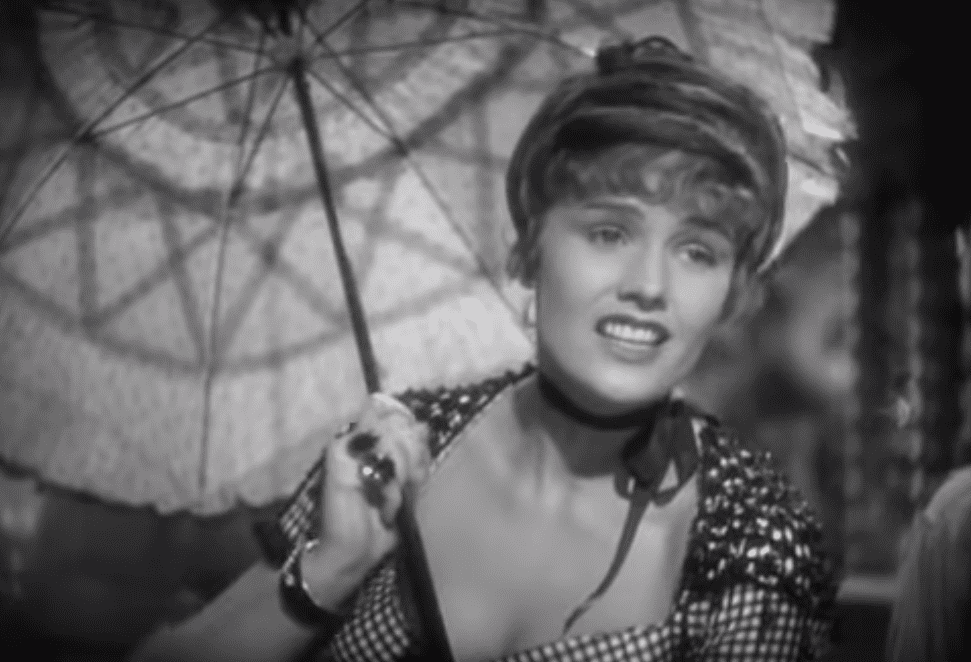 Come and Get It,United Artists
Come and Get It,United Artists
Acting Out
While Farmer had previously tried so ardently to deflect attention from her private life, she couldn’t seem to stay out of the tabloids. There were multiple arrests for disorderly conduct, public feuds with her former in-laws, and rumors about the actor parading down Sunset Boulevard without a top after a bar brawl. After a courtroom outburst, a judge sentenced her to 180 days in prison.
A Rock Bottom
Clearly, Farmer was having issues that ran much deeper than just acting out. During her hearing, the court failed to address these. However, thanks to her former sister-in-law, of all people, she finally got help. Her sister-in-law petitioned for the authorities to transfer her from prison to the psychiatric ward of the Los Angeles General Hospital.
A Different Type Of Big Break
She was transferred from there to the Kimball Sanitarium, where she was diagnosed with paranoid schizophrenia. If this story were to take place in 2018, this would hopefully be the moment where Farmer received treatment and care that could help her get her life back on track, but psychiatric medicine in the 1940s was quite different than what we’d expect from doctors today—with "cures" that seem more torturous than therapeutic.
 Come and Get It,United Artists
Come and Get It,United Artists
The Cure Is Worse Than The Disease
One treatment that Farmer was immediately subjected to was insulin shock therapy, where the patient is put into successive insulin comas, which can cause severe nausea, brain damage, or even, in extreme cases, death. Farmer later made a dramatic escape from the institution and confided in her family about the insulin treatments, who then complained to the courts that they’d never consented to such severe measures. The details were chilling.
Haunted By The Past
She claimed that doctors put her into successive daily comas over the course of 90 days—a much more serious regimen than medical professionals normally prescribed. Her mother undertook a court battle to have her released, and ultimately won. However, when the two got into a physical altercation, Farmer’s mother had her institutionalized once again.
 Wikimedia Commons
Wikimedia Commons
Mother Knows Best
Farmer spent the next few years in and out of both the hospital and her mother’s house. When officials formally discharged her from the hospital's jurisdiction, no one bothered to tell her. As a result, she lived in constant fear of being sent back to Western State Hospital in Washington. When she finally discovered that they'd officially discharged her, she took a job sorting laundry at a local hotel. In a twist of tragic irony, that same hotel had once hosted the world premiere of one of her movies.
The Final Years
Years passed quietly before Farmer attempted a comeback at the behest of her third husband. She tried to set the record straight about her downfall and did interviews opening up about her past struggles. She mounted her comeback in television and theater, and it was mostly successful, save for a few blips here and there—an inebriated driving charge among them. Generally, she became less of a target for the tabloids—that is, until after she passed on.
From Beyond The Grave
In 1970, Farmer passed on at the age of 56 after a quick battle with esophageal cancer. But, for all her insistence on keeping her private life private, Frances Farmer really became a household name when her absolutely sensational posthumous memoir came out. She titled it Will There Really Be a Morning? They revealed the true extent of what happened at Western State Hospital, including allegations of absolutely brutal assaults by male staff. She even claimed thay they made to eat her own excrement.
Failed By The System
Among other claims, she said that: "I was...gnawed on by rats and poisoned by tainted food. I was chained in padded cells, strapped into strait-jackets and half-drowned in ice baths". Further attention was drawn to Farmer’s treatment in Kenneth Anger’s infamous tell-all book Hollywood Babylon, where he named her the "Patron Saint of the Mad Starlets".
Both books were swift in their condemnation of the two systems that had failed Frances Farmer—whereas her memoir placed the blame on the mental health system, Hollywood Babylon claimed that it was Hollywood itself that had failed Farmer when she was at her most vulnerable. Will There Really Be a Morning? also worked to clear Farmer’s name of all the scandals that had plagued her in her life, but sadly, outrageous rumors would follow her even after her tragic end.
She'll Come Back As Fire To Burn All The Liars
In 1978, publishers released a highly fictionalized account of Farmer’s life titled Shadowland. In it, the book’s author, William Arnold, claimed that doctors had performed a transorbital lobotomy on Farmer during her time at Western State. Later, Arnold revealed that his book was actually highly fictionalized. However, the damage was done—a movie version of Farmer’s life, titled Frances, depicted the procedure. The "lobotomized starlet" became her legacy.
Trapped In The System
There was much more to Frances Farmer than just her rumored lobotomy and her time in institutions. Sadly, the more scandalous parts of her personal life have overshadowed her screen and stage appearances. Farmer's family failed her, and later, a power hungry biographer did even more damage. But mostly, Hollywood failed her. They dropped her like a hot potato as soon as her battle with depression made her seem too difficult.
It Still Happens
Farmer’s problems with the Hollywood system are also a general problem in the movie business. The silver screen demands a high degree of sensitivity and vulnerability from its performers, but when they’re too sensitive or vulnerable, Hollywood chews them up and spits them out. Farmer was far from the first star to seem to crack under pressure, and sadly, she wouldn’t be the last.
More To Come
Young actors who try and treat their problems often have their attempts sensationalized—think of the coverage of the infamous involuntary psychiatric hold placed on Britney Spears in 2008, or Amanda Bynes in 2014. As the conversation around mental health becomes more normalized and nuanced, hopefully, a change will come. Perhaps fewer will suffer the same fate as Frances Farmer, doomed to be dually remembered for the worst period in her life and a vicious posthumous rumor that’s never gone away.
Hollywood is known for chewing up and spitting out young starlets, but that doesn't mean it was always kinder to its heartthrobs. Take Montgomery Clift for instance—for him, the dark consequences of one night led to his complete undoing, and the business where he'd made his name showed him no sympathy...
Montgomery Clift, The Doomed Heartthrob
Back in the day, Montgomery Clift was THE dreamboat. He had it all: looks, talent, charisma, and of course, friends in high places. But one of those friends would spell Clift’s doom. One night, Elizabeth Taylor needled her BFF Clift into coming to her dinner party. Representing that introvert lifestyle, Clift resisted—he was tired, he wanted a night in—but Taylor wouldn’t take no for an answer.
Wrong Place, Wrong Time
In the end, Taylor got her way (when didn’t she?) and Clift attended her soirée. Hours later, he began to drive back home—and this is where everything derailed. Clift was so tired that he fell asleep at the wheel and violently crashed into a tree. Terrified, Taylor rushed to tend to her friend. To keep him from choking, she actually had to reach down his throat and retrieve shards of his teeth.
No Going Back
While Clift survived the crash, there was a dark aftermath. His horrific injuries led to him developing a dependence on painkillers. His addiction in turn made him act so erratically that Hollywood blacklisted their one-time golden boy. In the years after Taylor’s disastrous party, Clift fell deeper and deeper into his addiction and passed at just 45 years old.
Film scholars now call the period between the car crash and Clift’s early end "Hollywood’s slowest" end. That's got to rank up there with the saddest three words in the world. Clift's story is proof that a handsome face can cover up deep and lasting pain—but long before he came on the scene, a man nicknamed "The Great Stone Face" made thousands of people laugh, all the while hiding a dark and desperate life behind the scenes.
The Dark Side Of The Great Stone Face, Buster Keaton
Joseph Frank "Buster" Keaton was a performer from the very start. His only home was up on stage. Young Joe was just three years old when his parents brought him into their stage act. Performing was all he knew—and he happened to be born at the perfect time to take advantage of the new medium that would completely change the face of show-business: Film.
Child Star
His Vaudevillian childhood perfectly prepared him for a career in front of the camera. Before the days of stunt doubles and CGI, his utter fearlessness made for some of the most remarkable films of the silent era—and he managed to do all of his wildly dangerous stunts with his iconic deadpan expression. It's no wonder that Roger Ebert claimed The Great Stone Face was "the greatest actor-director in the history of the movies". But his life off screen was far from idyllic...and controversy followed him, even in his youth.
The Little Boy Who Can’t Be Damaged
The Three Keatons’ show would never fly today. It was barely even allowed at the turn of the century. For the most part, it involved Keaton’s mother playing the saxophone while he and his father took center stage. Young Buster would provoke his father in one way or another, and an enraged Papa Joe would respond by heaving his son against the scenery, or sometimes out into the audience. They even sewed a suitcase handle onto Buster’s clothes for more impressive throws.
Troublemaker
While audiences loved this Vaudevillian equivalent of Homer Simpson strangling his son Bart, the authorities were less pleased. The New York Society for the Prevention of Cruelty to Children had a particular bone to pick with this so-called "act". But while cries of child mistreatment unsurprisingly followed the Three Keatons almost anywhere they went, Buster himself was always quick to show them that he never had any bruises or broken bones.
While most children would probably be utterly terrified, the young Buster absolutely loved the show he did with his parents. Keaton performed with his parents for his entire childhood, but his father’s increasing alcoholism eventually put a strain on the trio’s working relationship. Finally, in 1917, Buster had had enough and decided to set off on his own. He was 21 years old.
Tears Of A Clown
It wasn’t long before Keaton got the chance to truly make a name for himself. He worked on pictures here and there before someone important finally took note. Joseph M. Schenck, a studio executive, saw that he had something in Keaton. In 1920, he created Buster Keaton Productions and gave Keaton the reins to start making his own movies.
At The Peak
The following decade would see Keaton’s greatest work, culminating in the 1927 classic The General, but there were storm clouds on the horizon. A series of career failures and two tumultuous marriages would see him descend into alcoholism and bankruptcy. A decade after being one of the world’s biggest stars, Keaton would be living in near-obscurity, struggling to eke out a living in a world that had passed him by.
Pushing The Limits
Keaton had been doing wild stunts for several years, but he didn’t ease up once he gained creative control—in fact, his setpieces and pratfalls only got more outrageous. As his popularity grew and he achieved more financial freedom, Keaton decided to really put his body on the line and see just what he could get away in the name of entertainment.
 Getty Images Buster Keaton, Captain Lew Cody and Jimmy Durante
Getty Images Buster Keaton, Captain Lew Cody and Jimmy Durante
A Dangerous Game
Keaton sat, completely untethered, on the outside of moving trains. He jumped into moving cars and out of second story windows. He dangled off of buildings and soared through the air—all with his trademarked morose expression, as if telling us the world is so completely absurd that even these wild antics don't merit a reaction.
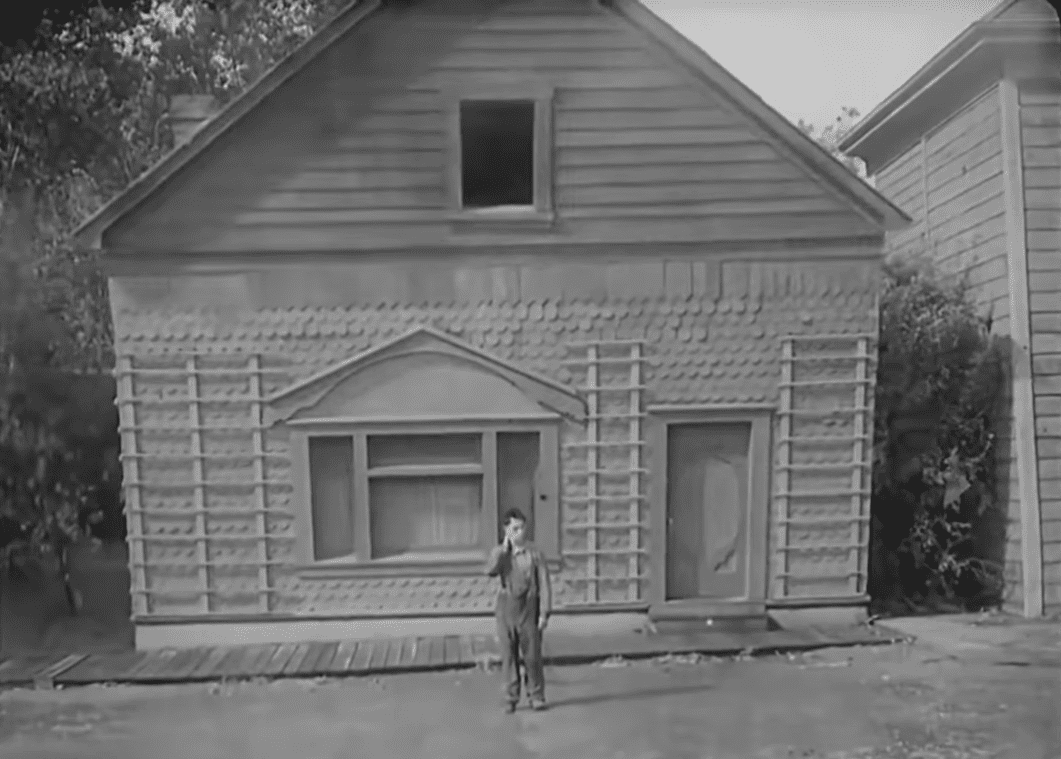 Steamboat Bill, Jr. (1928), United Artists
Steamboat Bill, Jr. (1928), United Artists
The Beginning of the End
Keaton’s remarkable streak of films in the 1920s made him a star near the level of Charlie Chaplin. At his peak, he was earning $3,500 a week—enough to build his legendary $300,000 home in Beverly Hills. He was also married for the first time in the 20s. He wed Natalie Talmadge in 1921, and the couple had two sons together.
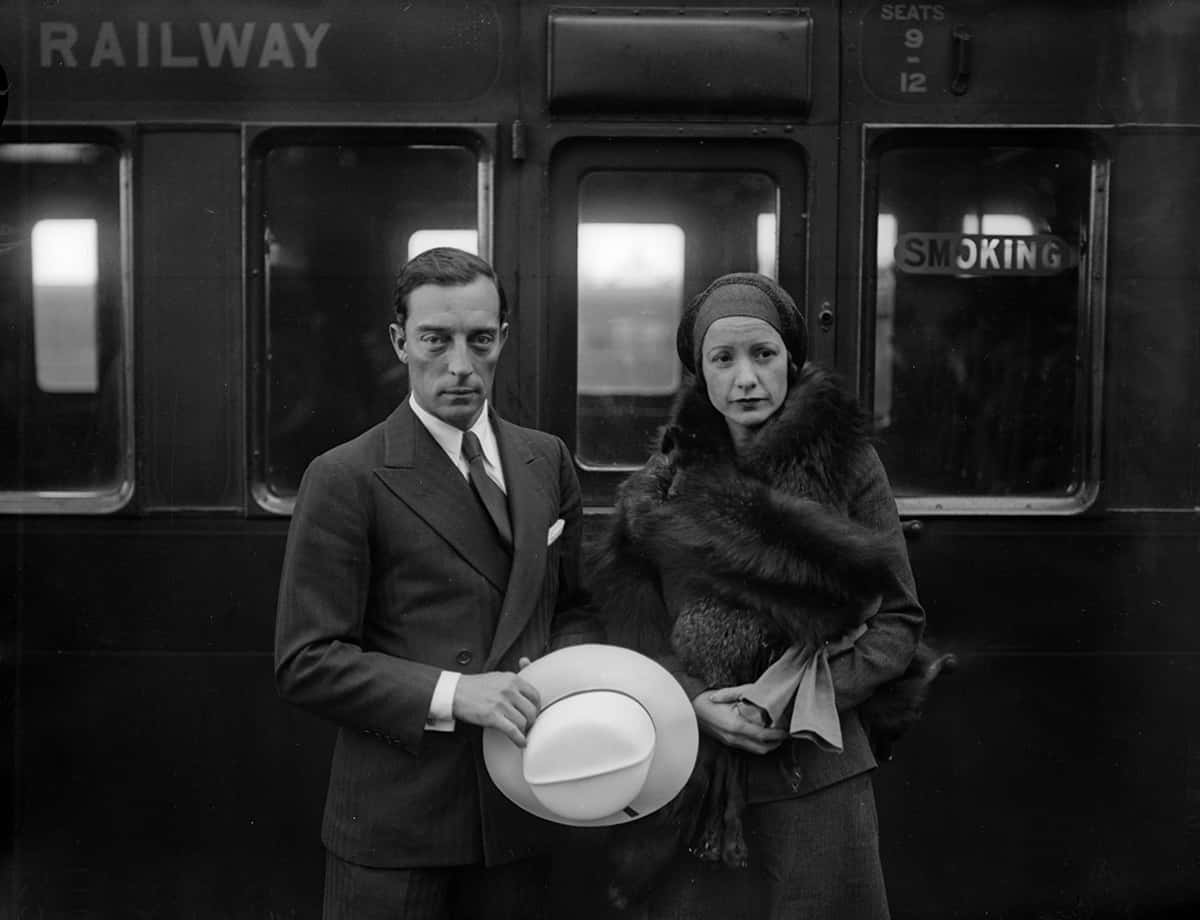 Getty Images Buster Keaton with his wife, Natalie Talmadge
Getty Images Buster Keaton with his wife, Natalie Talmadge
All For Nothing
By all accounts, the Jazz Age was a magical time for Keaton—yet few good things last forever. By the end of the decade, Keaton’s life began a serious downturn, and he fell into obscurity and alcoholism. In a cruel twist of fate, Buster Keaton’s fall from grace began with the best film he ever made. Keaton's film The General was a huge undertaking, but sadly, it was a total flop.
 Picryl
Picryl
Trouble At Home
The General’s failure was particularly hard on Buster Keaton, and his personal problems behind-the-scenes made it even worse. His marriage had been on the rocks since the birth of his second son. Not only had he and his wife had begun sleeping in separate bedrooms, but her extravagant spending habits had never sat well with him.
It's Over
Keaton and Talmadge separated in the mid-20s, and after a couple feeble attempts at reconciliation, she finally left him in 1932—but that's not the worst part. She took most of his fortune with her and refused to allow him any contact with his sons, whose last names she had legally changed to Talmadge. Keaton wouldn’t see the boys again for a decade.
Nowhere To Go But Down
While the 1920s saw Keaton’s meteoric rise to fame, the 1930s saw him crashing back down to earth. His wife had left him, he had no contact with his sons, and he’d lost control of his creative life. Hit after hit took their toll on him, and the usually exuberant and cheerful Keaton became deeply depressed.
Less than two decades earlier, as the movies left his Vaudevillian act obsolete, Keaton's father had fallen into alcoholism. Now here was Buster, the silent-film star who seemingly couldn't adapt to the world of talkies—and he too fell into the drink like his father.
The Great Depression
The 1930s were the darkest period in Buster Keaton’s life. He even briefly spent time in an institution—though, in the middle of the harrowing experience, Keaton managed to wow the doctors and orderlies by escaping from his strait-jacket with tricks that Harry Houdini had taught him. He might have been down, but Buster Keaton was still Buster Keaton.
Try, Try Again
Keaton got married for a second time, to his nurse Mae Scriven, in 1933—but the happy day was actually indescribably dark. His alcoholism was so severe at this point that he later claimed he remembered nothing about the ceremony, and Scriven would later say that he didn’t even know her first name until after they tied the knot. Not exactly a recipe for marital bliss.
By 1934, he filed for bankruptcy with just $12,000 to his name. The little money he earned was going to the bottle. Things looked grim for the one-time star—and it was about to get worse.
Dark Days
To make a bad situation even worse, Scriven caught Keaton cheating just a year after they married. She divorced him too, leaving him with next to no money and two ex-wives to support. After MGM terminated his contract, Keaton spent the years just scraping by. He worked as an uncredited writer for the comedy acts that succeeded him, like legends Red Skelton and the Marx Brothers.
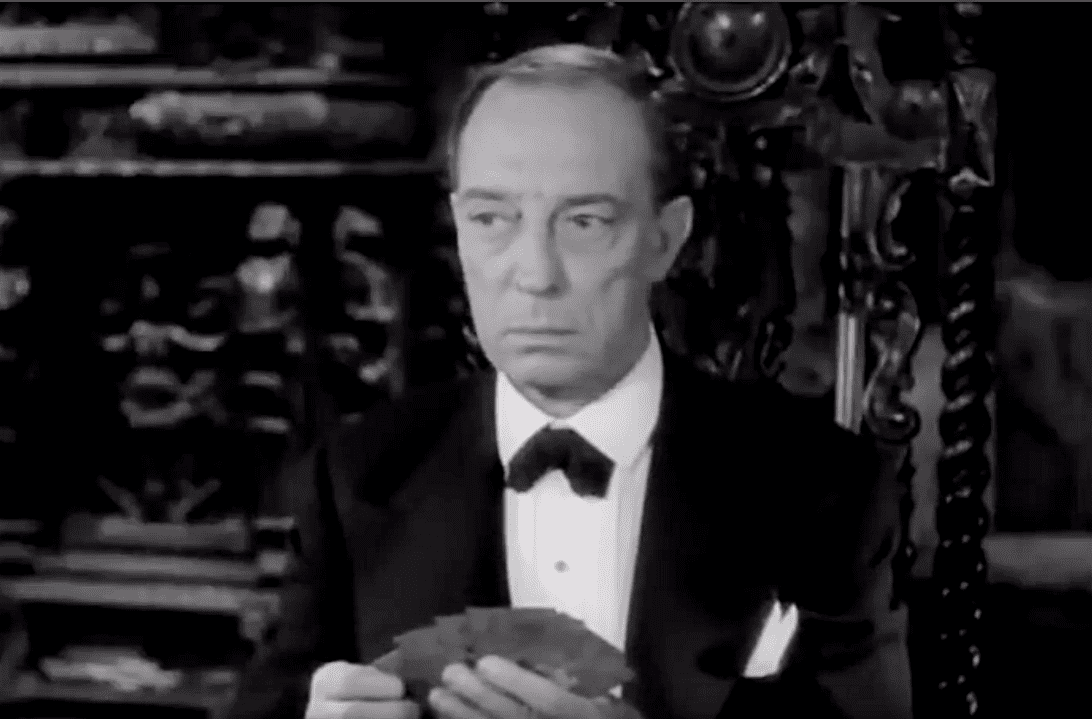 Sunset Blvd. (1950), Paramount Pictures
Sunset Blvd. (1950), Paramount Pictures
I'm A Survivor
He was barely making any money, and nearly all of it went to his ex-wives or to the bottle. Keaton had been resilient and bounced back before. But now, the one-time legend seemed determined to drink himself to a dark end in utter obscurity. Then, just as everyone thought he had hit rock bottom, The Great Stone Face proved he wasn’t finished yet.
The Love Of A Good Woman
Things began to turn around when Keaton married a younger dancer named Eleanor Norris in 1940. Though Keaton hadn’t exactly been lucky in love up to this point, Norris helped him get his life back together. She curbed his drinking and gave him some measure of stability. Though his previous two marriages had been relatively brief and painful, Keaton and Norris would remain together until his passing in 1966.
Back From The Edge
It looked for a time like Buster Keaton was doomed to a tragic Hollywood ending, but he managed an amazing turnaround. After nearly two decades of obscurity, he ended up back in the limelight thanks to the help of his friend Charlie Chaplin, and he managed to escape the poverty of the 1930s and 40s. In the final decade of his life, he was making as much money as he did at the height of his career—though this time, he lived a far more modest lifestyle.
While Keaton and Norris were a match made in heaven, not every marriage can end with a happily ever after—and no story is more illustrative of that than the romance between Jean Harlow, Hollywood's first blonde beauty, and her second husband.
Jean Harlow, The Blonde Beauty With a Hidden Scandal
Jean Harlow is a classic example of Hollywood’s obsession with lifeless blondes. After bursting onto the silver screen with her iconic eyebrows and platinum locks, Harlow tragically passed on at just 26 years old. But that’s not even the most dramatic thing about her life. It’s much less known, but the story of Harlow’s second marriage to MGM studio executive Paul Bern is right out of a psychological thriller. Buckle up, y’all!

A Tragically Short Marriage
A mere two months after Harlow and Bern walked down the aisle, the authorities discovered Bern’s lifeless body. At first, they thought that Harlow had shot her beau, but then they saw the strange note next to Bern’s body. It referenced a "frightful wrong" he’d dealt Harlow and mentioned his "abject humiliation". Mysterious, right?
The Plot Thickens
Film scholars believe that Bern may have been insecure about his privates or his family’s history of self-harm. Others insist that MGM’s notorious fixer, Eddie Mannix, staged the whole scene to clear their starlet, Harlow, of any suspicion (and...shade Bern’s manhood in a catty forged note? An interesting strategy). But there was another missing piece.
The Other Woman
No explanation of Bern’s strange end is complete without mentioning one key player: Bern’s troubled ex, Dorothy Millette. While people suspect that she could have had a hand in her ex’s demise, no one knows the truth. However, we do know that she took their break-up very badly...and that she leaped to her dark end only a few days after the discovery of Bern’s body. And the tragedies didn't end there...
Damage Control
In the wake of the scandal, MGM worked overtime on distancing Harlow from it all, even arranging a marriage between Harlow and her friend Harold Rosson. The two were in on the scheme. Eight months later, they signed the divorce papers. Later, Harlow found love with her frequent co-star William Powell—though by this time she was just about done with matrimony (fair enough, Jean). The two never wed. But Harlow’s heartache was far from over.
It All Falls Down
In 1937, her health took a terrifying turn. She had been mildly ill for months, but while filming Saratoga, the star began to complain of nausea, bloating, and abdominal pain. It got so bad that she had to lean on her co-star and friend Clark Gable between takes. When they found out the truth, it was too late.
Flying Blind
Harlow took time off work to recover from what doctors now diagnosed as an inflamed gallbladder. But when Clark Gable visited her, he was heartbroken by what he saw. She was severely bloated and, astonishingly, had the smell of urine on her breath. Soon after that, medical professionals confirmed the young, beautiful girl was in the final stages of kidney failure. But how could such a horrible fate befall such a young, vibrant woman?
Gone Too Soon
The warning signs were there, but no one paid attention to them. On June 6, 1937, Harlow slipped into a coma at the hospital. By the next morning, she had passed. She was only 26 years old. Harlow’s pallid complexion, many illnesses, and even an earlier severe sunburn had all pointed to kidney failure. Yet everyone missed the bigger picture.
Rest In Glamour
Harlow’s family buried her in a gown from one of her films. They placed a white gardenia in her hand and a note from Powell that read, "Good night, my dearest darling". The inscription on her grave says simply, "Our Baby".
Sources: 1, 2, 3, 4, 5, 6, 7, 8, 9, 10, 11, 12, 13, 14, 15, 16, 17, 18, 19



